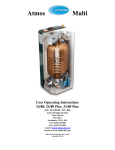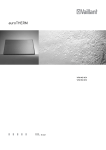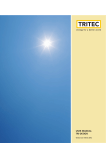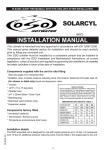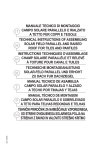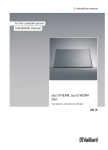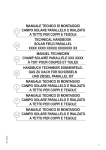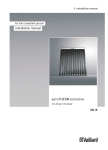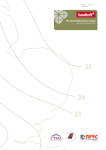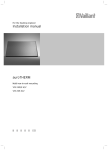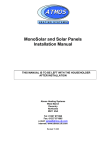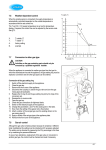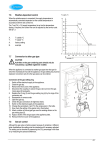Download Atmos HE26 User manual
Transcript
ATMOS HEATING SYSTEMS Twin Coil Sealed Solar System Installation & User Manual THIS MANUAL IS TO BE LEFT WITH THE HOUSEHOLDER AFTER INSTALLATION Atmos Heating Systems West March Daventry Northants NN11 4SA Tel: 01327 871990 Fax: 01327 871905 e-mail: [email protected] internet: www.atmos.uk.com T2 panels (& enlarged Appendix) Issue 3.12.07 Twin Coil Sealed Solar System Ins Man Page 2 of 15 1.0 1.1 General Introduction Water heated by the solar panels is pumped down to a well insulated twin coil hot water storage cylinder under the control of an electronic controller. The solar coil in the lower section of the cylinder provides solar heat, whilst the upper coil is connected to the boiler to provide the back up when the solar heat is insufficient. The solar system is sealed and requires a special glycol anti-freeze fluid to protect against freezing. This type of system has to be designed for high temperatures and high pressures and therefore special solar components must be used. 1.2 Selecting the location of the Solar Panel 1.3 1.2.1 Select the most southerly facing and unshaded area of the roof for the solar panel. Be aware of the movement of shadows across the proposed location from chimneys, trees, etc and try to minimise this effect. Often the best position technically and visually, is in the centre of the roof. 1.2.2 The minimum angle of the roof, and therefore the solar panel, should be 30 degrees. The maximum height of the solar panel should normally be 10 metres. 1.2.3 Ensure that there will be enough space to fit the solar panel. Because of the flashing, in the case of roof-integrated panels, it is best to have at least one column of tiles between the panel and a vertical edge and at least 2 rows of tiles between the panel and the top of the roof. Unpacking the Solar Panels and Warning Unpack panels carefully so that they are not damaged. WARNING 1. Take care when carrying the solar collector panels to the roof, because of their size and weight. Weight of single panel = 44.5 Kg and size = 2090 x 1080mm. 2. Keep the panels covered while working on the roof. When the absorber surface is exposed to light, the whole solar panel will become very hot and the heat will be conducted to the external pipework which may become too hot to touch. Note that these temperatures can reach over 200 degree C and when touched would cause severe burns. Twin Coil Sealed Solar System Ins Man Page 3 of 15 2.0 Installing Roof-Integrated Solar Panels (For pantiles, etc, but not slates) See separate leaflet available from Atmos. 3.0 Installing On-Roof Solar Panels 2 Panels Twin Coil Sealed Solar System Ins Man Page 4 of 15 3 Panels Twin Coil Sealed Solar System Ins Man Page 5 of 15 1. Remove roofing tiles in the area of solar panel assembly (upper edge of the collector panels approx 3 to 4 rows of tiles from the ridge). 2. Fasten the supporting profile to the rafters using wood screws, 80 to 100mm above the lathwork. Pay attention to weathering of the profile, in respect to the position of the panel. 3. Attach hooks to the supporting profile according to the picture shown. Do not tighten the screws as further adjustment will be necessary. 4. Attach the supporting G-profile to the lower hooks, as shown in the picture. For 3 panels, set up the G-profiles using 330mm connecting piece. 5. To the upper hooks, attach the U-profile in line with the supporting G-profile of the lower side. For 3 panels, set up the two U-profiles using L-connector and self tapping screws. 6. Tighten all screw connections. 7. After drilling the holes for the solar panels pipework, replace the roofing tiles. 8. Position the solar panels as shown in the picture, using packing as required to space the panels 22mm apart. Tighten the screw connections. NOTE: The panels should be connected as shown in section 6. The compensator (for expansion) is within the panel and has stainless steel pipe with male connector. 9. Using the self-tapping screws, secure the solar panels to the U profile. Be careful not to strip the thread. 10. Check the seating of the parts and the tightness of all the pipe joints. Quantity 2 3 pan pan 2 2 2 6 8 6 8 1 1 1 1 1 1 12 16 12 16 4 6 4 8 12 16 12 16 1 1 6 8 4.0 Description 2000mm Supporting profile 1500mm Supporting profile Bearing hook Fastener 2215mm G-profile 1115mm G-profile 2215mm U-profile 1115mm U-profile 8 x 50mm screw 6 x 20mm screw 5.5 x 16mm A2 self tapping screw 8 x 80mm wood screw M8 Nuts/washers M6 Nuts/washers 330mm connecting piece C (Zn) 300mm connecting piece L (AlMgSi) 24mm diameter packing Installing Solar Panels on Flat Roofs Solar panels may be installed on flat roofs using a separate A-frame. Contact Atmos for more details. 5.0 5.1 Installing the System, Operation and Maintenance Basic Guidelines See the System and Control diagrams 1. Compression fittings suitable for the application can be used. 2. Solar circuit pipes must be insulated with high temperature insulation (eg Armaflex). 3. The power cable must be run to the BS3 controller (via a wiring centre or junction box if using an unvented tank) from a 230 volt, 5 amp fused, earthed electrical supply. 4. The collector and tank sensors are supplied with the BS3 controller. 5. The solar circuit must be plumbed to the tank lower coil and the tank sensor S2 (using heat conductive paste) fitted into the sensor pocket. Twin Coil Sealed Solar System Ins Man Page 6 of 15 6. Ensure that the sensor cables are not in contact with uninsulated pipes, and are kept separate from other wiring and adequately clipped. If the sensor cable is not long enough, use a connecting box and 2 core cable (heat resistant if near any hot pipes). The cable should not look the same as mains cable. 7. The solar expansion vessel should be pre-pressurised to 2.5 bar. 8. Fill the system with the Tyfocor LS glycol solution, without any dilution, through the filling loop double check valve, using Solar Filling Pump set with filter(consult Atmos). Flush through first and refill. Check very carefully for leaks. 9. Pump speed set to the highest. 10. On commissioning, bleed the manual air vents. 11. Solar system pressurised at 3 to 4 bar. 12. Solar system controller operation: System arrangement 1 selected. SMX (store max temp) set at 60 deg C or 65 deg C (Note: A TMV valve should normally be fitted to the hot water supply). Check that the controller is left in AUTO (ie HND1 is in auto). 13. Pump operation checked and flow rate set to 4 litres/min (based on 2 panels). 5.2 Operation of the Controller (Resol type BS/3) Provides simple control of solar circulating pump based on adjustable temperature differential on (DTO) and temperature differential off (DTF), measured with sensors fitted to solar panel and hot water cylinder. The solar pump is switched on when the difference in temperature at the solar panel sensor S1 (indicated by channel COL at the controller) and the hot water sensor S2 (indicated by channel TST at the controller) is larger than the given channel DTO. The solar pump is switched off when the difference in temperature between S1 and S2 is smaller than the given channel DTF. If the temperature rises above the maximum storage temperature channel SMX, the solar pump switches off. If a temperature of above 140°C (factory setting, but adjustable channel EM at the controller) is reached at the solar panel sensor, the solar pump is switched off. WARNING 1. The controller is electrically operated. Improper installation or attempted repair can cause a life-threatening electric shock hazard. Only adequately qualified specialist personnel must perform installation and commissioning. Repairs are to be carried out only by the manufacturer. 2. Switch off the power supply to the controller before opening the housing. 3. The controller is an electronic device for use in conjunction with a hydraulic circuit in accordance with the manufacturer's specifications. The device is not to be used for any other purpose. 4. It may be necessary to electrically suppress strongly inductive loads in the vicinity of the controller (contactors, solenoid-operated valves, etc.). 5.3 Inspection & Maintenance 1. Regularly check that there are no red flashing LED’s at the controller. 2. Regularly check that the system pressure at the pressure gauge at the pumping station is approx 3 to 4 bar. Fluctuations are normal, but if the gauge shows low pressure constantly, then contact your Installer/Service engineer. More fluid must be pumped into the system, but only use the same type of glycol fluid as installed. 3. It is advisable to test and check the glycol fluid every 3 years, which must be carried out by your Installer/Service engineer. Twin Coil Sealed Solar System Ins Man Page 7 of 15 6.0 Technical Specifications & Diagrams Construction Absorber Efficiency Other information Outside dimensions Weight Frame Absorber area Glass Undersidel insulation Side insulation Connection All-copper absorber with highly selective surface Absorption Emissivity Working pressure Content 2090 x 1080x 103 mm 44.5 kg Black anodized alloy AIMgSI 0.5 2,018 m2 Solar th. = 4 mm, safety glass Transmittance of solar radiation e = 90%; Fe2O3 content = 0.05% EN 572-5 Safety construction glass Mineral wool = 66 mm thick Mineral wool = 20 mm thick G3 + flat packing 95 % +/- 2% 5% 2 - 4 Bar 1.1 Litre Certification by an independent testing laboratory ISE Freiburg EN 12975-1,2 Maximum efficiency Stagnation temperature (no load operation) η0= 0.77(77%) 202°C Guarantee period 5 years Life expectancy 25 – 30 years Twin Coil Sealed Solar System Ins Man Page 8 of 15 SOLAR SYSTEM DIAGRAM Solar Sensor S1 (Panel sensor FKP6) TOP OF PANELS NOTE FLOW should go horizontally into roof space, or with a rise to air vent before dropping to hot water tank. Manual Air Vent (Fit at highest point) 1 2 22mm solar panel FLOW with Armaflex HT 13mm insulation 4 Solar Panel Solar Panel solar expansion vessel 3 1 5 2 22mm solar panel RETURN with Armaflex HT 13mm insulation Pump station and controller NOTE Unvented system fittings not shown Expansion vessel to be fixed 240 volt switched supply Top coil Boiler connection Sensor S3 (optional) Bottom coil Solar collector Sensor S2 Drain cock at lowest point Hot water tank indirect Twin Coil Sealed Solar System Ins Man Safety discharge (glycol) Atmos Heating Systems Installation diagram for Twin coil tank with Single station pump set & BS/3 controller KEY 1. Integrated compensator within panel has stainless steel pipe with male connection (flexi connector). 2. ¾ inch brass end cap with washers. 3. 22mm ¾ inch MI compression elbow with washers. 4. a) Connect ¾ inch brass nipple in one end of ¾ inch brass tee. b) Connect ¾ x ½ inch brass bush & ½ inch sensor pocket in other end. c) Connect 22mm x ¾ inch MI compression straight into tee branch d) Connect assembly to panel ¾ inch nipple & washers to union nut. e) Insert black 6mm solar sensor into pocket and take cable through flashing to BS/3 controller. 5. Connect brass nuts on copper tails. Page 9 of 15 Solar Controller BS Controls Diagram NOTES 1. For an OSO Solarcyl unvented twin coil tank, wire the lower thermostat as shown using a wiring centre or junction box. Fit the tank sensor S2 (using heat conductive paste) into the sensor pocket beside the lower thermostat. 2. For a RCM/Stanley unvented twin coil tank, take the lower thermostat and remove the control thermostat part, so that just the 85 deg C limit thermostat is left. Fit the tank sensor (using heat conductive paste) and the limit thermostat into the lower pocket (double segment) and bring the sensor cable out through the thermostat spare gland. 3. Keep sensor cables separate/apart from other cables. 4. An additional sensor S3 can be fitted into the pocket near the top of the tank, to provide temperature indication only at the Solar Controller. Twin Coil Sealed Solar System Ins Man Page 10 of 15 7.0 7.1 Appendix Commissioning Check Sheet Check List Tick/Comment 1. Solar panel is in good location and without significant shading. 2. Solar panel orientation is correct and flow pipe taken to upper connection of panel. 3. Solar panel is securely mounted and flashing secure (if appropriate). 4. Solar panel pipes are insulated with high temperature insulation (eg Armaflex). 5. Panel temperature sensor is fitted in place correctly. 6. Roof fixings robust and weather tight; roof penetrations made good. 7. A pressure relief valve (6 bar) fitted and discharge is taken to a safe low level outlet. 8. Panel sensor cable (silicon type) is not in contact with the panel pipes, and is kept separate from other wiring and adequately clipped. 9a. Power cable has 230 volts, 5 amp fused, earthed electrical supply and cable to pump is heat resistant type. 9b. For an unvented tank, the live connection must be interrupted by the tank lower stat (as shown in the Appendix). 10. Equipotential bonding is refitted. 11. Pump speed set to the highest. 12. Solar panel system has been filled with anti-freeze, anti-corrosion fluid. 13. De-aeration valves manually bled. 14. Solar panel system pressurised at 3 to 4 bar. 15. Solar system controller operation checked, and the controller left in AUTO. 16. The pump unit is fixed securely and not vibrating or noisy. Pump operation checked and flow rate set to approx 4 litres/min for 2 panels, alternatively approx 6 litres/min for 3 panels (based on 1litre/min per m2 of absorber area x no of panels). 17. System operation checked and system checked for leaks. 18. Maintenance of system explained to the Customer and the Installation Manual left with the Customer, with this sheet completed and signed. Installed Equipment & Installer Record Panel type and quantity Cylinder size & type Controller type Controller settings if different from factory settings Glycol solution type and approx litres Installer’s Name (IN CAPITALS) or firm Installer’s Signature Installer’s Phone No Date of Completion Twin Coil Sealed Solar System Ins Man Page 11 of 15 7.2 Installation Diagram for RCM Unvented Twin Coil tank with HE26 Boiler Note Tank is RCM/Stanley unvented indirect tank Note: This is a diagrammatic illustration only, and does not override manufacturer’s instructions for boiler and unvented hot water tank. Solar circuit shown on page 9. Atmos InterSystem HE26 condensing gas boiler Unvented tank expansion vessel (white) as supplied with tank. Connect to cold water inlet assembly with braided hose. Electrical connection; All connections are 240 volt therefore use 240 volt switch live on boiler terminals (1 is the switched live input) Room thermostat Hot water out to taps Secondary hot water return (blank off if not required) Pocket for solar sensor S3 (optional) Time-clock programmer Flow Return Terminal box P&T valve to tundish and discharge Thermostat for boiler control. Immersion heater Two port motorised valves 240 volt switched supply Gas supply Solar cutout stat & solar sensor S2 pocket Flow and return to radiators Solar coil flow and return connections Twin Coil Sealed Solar System Ins Man Cold inlet with valve assembly and expansion vessel as supplied with tank Page 12 of 15 7.3 Controls Diagram for RCM Unvented Twin Coil tank with HE26 Boiler (Note: Diagram shows Salus controls) Twin Coil Sealed Solar System Ins Man Page 13 of 15 7.4 Installation Diagram for OSO Unvented Twin Coil tank with HE26 Boiler Note Tank is OSO unvented tank with internal secondary expansion Note: This is a diagrammatic illustration only, and does not override manufacturer’s instructions for boiler and unvented hot water tank. Solar circuit shown on page 9. Atmos InterSystem HE26 condensing gas boiler Electrical connection; All connections are 240 volt therefore use 240 volt switch live on boiler terminals (1 is the switched live input) Time-clock programmer Room thermostat Hot water out to taps Pocket for solar sensor S3 (optional) Flow Return P&T valve to tundish and discharge Terminal box Commissioning valve and Secondary hot water return (if required) Thermostat for boiler control. Solar cutout stat & Immersion heater Two port motorised valves 240 volt switched supply Gas supply Pocket for solar sensor S2 Flow and return to radiators Solar coil flow and return connections Twin Coil Sealed Solar System Ins Man Cold inlet with valve assembly as supplied with tank Page 14 of 15 7.5 Controls Diagram for OSO Unvented Twin Coil tank with HE26 Boiler (Note: Diagram shows Salus controls) Twin Coil Sealed Solar System Ins Man Page 15 of 15















